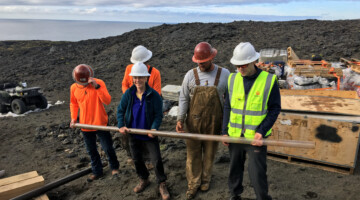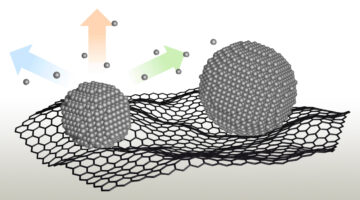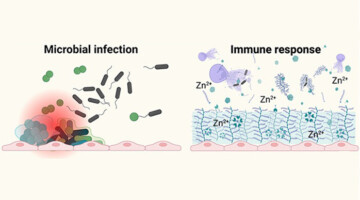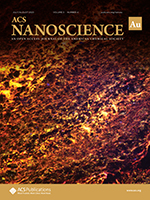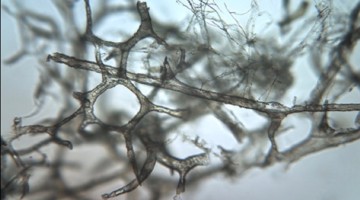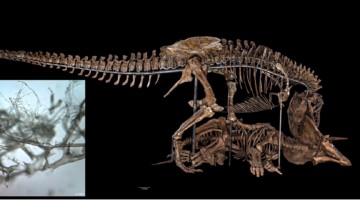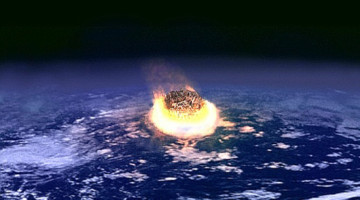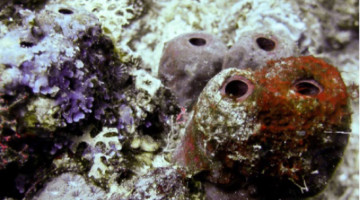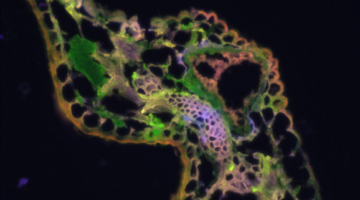Surtsey, a very young oceanic island in Iceland, emerged through explosive volcanic activity in 1963. Utilizing various techniques, including x-ray microdiffraction at the ALS, researchers gained unique insights into the transformation of volcanic glass to form mineral cements in the basaltic rock of underwater volcanoes. Read more »
Tracking Platinum Movement on Fuel-Cell Electrodes
Researchers tracked the movement of the platinum nanoparticles that catalyze reactions in polymer electrolyte fuel cells (PEFCs) and correlated this movement with nanoparticle degradation. The results yielded solutions that can immediately reduce platinum waste in emission-free heavy-duty fuel-cell vehicles. Read more »![]()
![]()
Immune Response Spurs Growth of “Soft” Kidney Stones
Matrix stones are an unusual type of soft kidney stone closely associated with the presence of bacteria from unchecked urinary tract infections. Researchers conducted a comprehensive study of surgically extracted matrix stones, work that highlights how host defense mechanisms against microbes can simultaneously encourage harmful stone formation. Read more »
Organic Matrix Derived from Host–Microbe Interplay Contributes to Pathological Renal Biomineralization
A composite image of a rare form of kidney stone, illustrating extensive organic filamentous networks abundant with immune response-related proteins such as calprotectin (displayed in red), myeloperoxidase (in yellow), and DNA molecules (in blue). Originating from intricate host-microbe interplay, these organic networks promote the heterogeneous nucleation and precipitation of inorganic particulates. Read more »
Survival of T. rex Microvascular Structures from Deep Time
Researchers used several analytical techniques at the ALS to demonstrate how soft-tissue structures may be preserved in dinosaur bones, countering long-standing scientific dogma that protein-based body parts cannot survive more than one million years. Read more »
Berkeley Lab Helps Reveal How Dinosaur Blood Vessels Can Preserve Through the Ages
A team of scientists used infrared and x-ray imaging performed at the Advanced Light Source to determine the chemical mechanisms that allow soft tissue structures to persist in dinosaur bones—countering the long-standing scientific dogma that protein-based body parts can’t survive more than 1 million years. Read more »
From Moon Rocks to Space Dust: Berkeley Lab’s Extraterrestrial Research
Berkeley Lab has a well-storied expertise in exploring samples of extraterrestrial origin. This research—which has helped us to understand the makeup and origins of objects within and beyond our solar system—stems from long-standing core capabilities in structural and chemical analyses and measurement at the microscale and nanoscale. Read more »
Bacterial Symbiont Sequesters Arsenic and Barium in Sponges
Researchers used x-ray fluorescence, spectroscopy, and diffraction to study how populations of symbiotic bacteria can act as a detox organ in a host with no organs. The bacteria, members of the species Entotheonella, accumulate and mineralize large quantities of arsenic and barium in sponges. Read more »
Manganese Reduction-Oxidation Drives Plant Debris Decomposition
ALS research has shown that manganese reduction-oxidation (redox) reactions are an important factor in controlling the rate of plant debris decomposition. Understanding the role of manganese will help build better models to predict how litter decomposition rates—and thus nutrient cycling and the ecosystem carbon balance—may behave in future climate scenarios. Read more »![]()
![]()
An Evolutionary Arms Race for Sulfur
Recent work at the ALS shows that the viruses infecting sulfur-oxidizing bacteria in the deep sea carry bacterial genes for the oxidation of elemental sulfur. Although the viruses themselves cannot use the sulfur, they likely supplement bacterial sulfur oxidation and then exploit the generated energy for viral replication. Read more »
